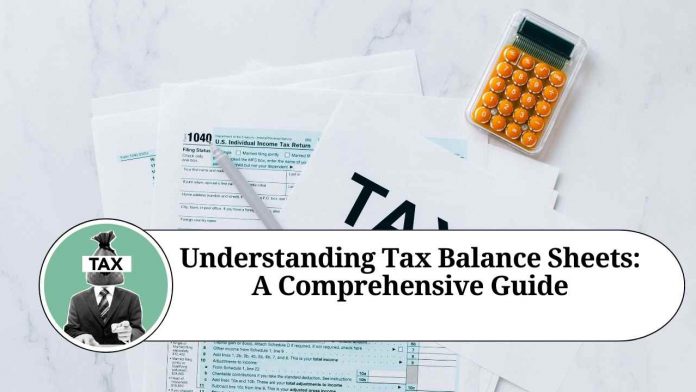Tax balance sheets are an essential tool used by individuals and businesses to organize and track their tax-related financial information. They provide a snapshot of a taxpayer’s financial position, detailing assets, liabilities, and equity for tax purposes. Understanding tax balance sheets is crucial for effective tax planning and compliance. In this blog post, we will delve into the intricacies of tax balance sheets, explaining their components, benefits, and how to create one.
What is a Tax Balance Sheet?
A tax balance sheet, also known as a tax return balance sheet or Schedule L, is a financial statement that reflects the financial position of a taxpayer at a specific point in time for tax reporting purposes. It differs from a regular balance sheet used for financial reporting as it adheres to specific tax rules and regulations.
Components of a Tax Balance Sheet:
- Assets: This section includes all the assets held by the taxpayer, such as cash, accounts receivable, investments, inventory, real estate, and personal property. Assets are categorized based on their nature and are reported at their tax basis rather than fair market value.
- Liabilities: Liabilities encompass the debts and obligations owed by the taxpayer. Examples include loans, mortgages, credit card debt, accounts payable, and other liabilities. Similar to assets, liabilities are reported on a tax basis.
- Equity: Equity represents the taxpayer’s ownership interest in their assets. It is calculated as the difference between total assets and total liabilities. In a tax balance sheet, equity may include items like contributed capital, retained earnings, and other equity accounts.
Benefits of a Tax Balance Sheet:
- Accurate Tax Reporting: A tax balance sheet helps ensure accurate reporting of financial information for tax purposes, reducing the risk of errors and potential penalties.
- Tax Planning: By analyzing the components of a tax balance sheet, individuals and businesses can identify tax-saving opportunities, such as deductions and credits, and make informed decisions regarding asset allocation and liabilities.
- Loan Applications: Lenders often require tax balance sheets when evaluating loan applications. A well-prepared tax balance sheet can enhance credibility and increase the likelihood of securing favorable loan terms.
Creating a Tax Balance Sheet: To create a tax balance sheet, follow these steps:
- Gather Financial Information: Collect all relevant financial records, including bank statements, investment statements, loan statements, and other documents reflecting your assets, liabilities, and equity.
- Classify Assets and Liabilities: Categorize your assets and liabilities based on their tax classification. Refer to tax guidelines and regulations to ensure proper classification.
- Determine Tax Basis: Determine the tax basis of your assets and liabilities. The tax basis generally represents the original cost plus or minus adjustments for tax purposes.
- Calculate Equity: Calculate the equity by subtracting the total liabilities from the total assets.
- Fill Out the Tax Balance Sheet: Use the appropriate tax forms provided by the tax authority, such as Schedule L for individual taxpayers or Form 1120 for corporations, to record your financial information.
- Review and Validate: Double-check all the entries to ensure accuracy and completeness. Seek professional assistance if necessary.
Conclusion
A tax balance sheet is a valuable tool for organizing and reporting financial information for tax purposes. It provides a snapshot of a taxpayer’s financial position and plays a vital role in tax planning, compliance, and loan applications. By understanding the components and benefits of a tax balance sheet, individuals and businesses can enhance their financial decision-making and ensure accurate tax reporting. Remember, consulting with a tax professional can provide valuable insights tailored to your specific circumstances.
Other Related Blogs: Section 144B Income Tax Act
Frequently Ask Question
Q: What is the purpose of a tax balance sheet?
A: The purpose of a tax balance sheet is to provide a snapshot of a taxpayer’s financial position for tax reporting purposes. It helps organize and present information on assets, liabilities, and equity to ensure accurate tax reporting and compliance.
Q: How does a tax balance sheet differ from a regular balance sheet?
A: A tax balance sheet differs from a regular balance sheet used for financial reporting. The key difference is that a tax balance sheet adheres to specific tax rules and regulations, while a regular balance sheet follows generally accepted accounting principles (GAAP). Tax balance sheets report assets and liabilities at their tax basis rather than fair market value.
Q: Who needs to create a tax balance sheet?
A: Both individuals and businesses may need to create a tax balance sheet. Individuals use it for personal tax reporting, while businesses use it for corporate tax reporting. Additionally, tax balance sheets may be required when applying for loans or during audits by tax authorities.
Q: What are some common components of a tax balance sheet?
A: The components of a tax balance sheet include assets, liabilities, and equity. Assets can include cash, investments, inventory, and real estate. Liabilities encompass debts and obligations, such as loans and accounts payable. Equity represents the ownership interest in assets and can include contributed capital and retained earnings.
Q: How can a tax balance sheet help with tax planning?
A: A tax balance sheet can be a valuable tool for tax planning. By reviewing the components of the balance sheet, individuals and businesses can identify tax-saving opportunities, such as deductions and credits. It helps in making informed decisions regarding asset allocation, liability management, and overall tax strategy.
Q: Are there specific guidelines for preparing a tax balance sheet?
A: Yes, there are specific guidelines for preparing a tax balance sheet. These guidelines vary depending on the tax regulations and reporting requirements of the country or jurisdiction. It is important to refer to the relevant tax authority’s guidelines and forms to ensure accurate preparation of the tax balance sheet.
Q: Can I create a tax balance sheet on my own, or do I need professional help?
A: While it is possible to create a tax balance sheet on your own, seeking professional help is advisable, especially for complex financial situations or when dealing with intricate tax rules. Tax professionals can provide guidance, ensure compliance, and help optimize tax planning strategies based on your specific circumstances.
Q: How often should I update my tax balance sheet?
A: Tax balance sheets should be updated at least annually to reflect the financial position at the end of each tax year. However, it is a good practice to review and update the balance sheet whenever significant financial changes occur, such as major asset acquisitions or the incurrence of significant liabilities.
Q: Can I use software or online tools to create a tax balance sheet?
A: Yes, there are various software applications and online tools available that can assist in creating a tax balance sheet. These tools often provide templates and guidance to help streamline the process. However, it is important to ensure the accuracy of the information entered and review the final output for compliance with tax regulations.
Q: What should I do if I discover errors on my tax balance sheet after submission?
A: If you discover errors on your tax balance sheet after submission, it is important to rectify them as soon as possible. Contact the relevant tax authority or consult with a tax professional to determine the appropriate steps for correction. In some cases, an amended tax return may need to be filed to correct the errors.




















